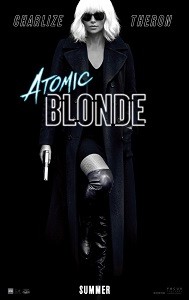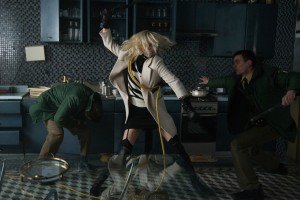 About halfway through “Atomic Blonde,” our heroine, MI6 super-agent Lorraine Broughton (Charlize Theron) is suddenly faced with getting her wounded informant “Spyglass” (Eddie Marsan) to safety. They’re caught in the middle of a crowded Berlin protest march and a sniper is trained on them from a window somewhere high above the street. Ducking into the building in which the sharpshooter and his fellow Soviet agents are lying in wait, Broughton sets Spyglass to the side to duct tape his gut wound as she then proceeds to infiltrate the top floor; then, working her way downward, she violently murders everyone in the building. She uses guns, knives, broken glass, re-purposed hot plates, and anything and everything else she can get her hands on, all the while enduring a beating so vicious that she’s finally reduced to staggering and lurching about: a swollen, purple feline whose strand of grace is so innate that, even when diminished, she still manages to land on her feet. This lengthy sequence, presented as one unbroken shot (artificial in construction, albeit near-seamless), is a beautifully choreographed ballet of violence offset by frenetic verite-style documentary camerawork. The heightened realism of the continuous moment places us uncomfortably close to the necks breaking and jaws shattering, circling us, drawing us in, and then pushing us aside, helpless and hapless and defenseless in the midst of the chaos. By the time Broughton has finished off her final adversary and lurches back out onto the street, barely able to stand and yet still managing to support her wounded informant, we’re gasping for air and checking ourselves for bruises…only to discover that the shot still isn’t breaking, and a high speed vehicle chase has begun, whether we’re ready for it or not.
About halfway through “Atomic Blonde,” our heroine, MI6 super-agent Lorraine Broughton (Charlize Theron) is suddenly faced with getting her wounded informant “Spyglass” (Eddie Marsan) to safety. They’re caught in the middle of a crowded Berlin protest march and a sniper is trained on them from a window somewhere high above the street. Ducking into the building in which the sharpshooter and his fellow Soviet agents are lying in wait, Broughton sets Spyglass to the side to duct tape his gut wound as she then proceeds to infiltrate the top floor; then, working her way downward, she violently murders everyone in the building. She uses guns, knives, broken glass, re-purposed hot plates, and anything and everything else she can get her hands on, all the while enduring a beating so vicious that she’s finally reduced to staggering and lurching about: a swollen, purple feline whose strand of grace is so innate that, even when diminished, she still manages to land on her feet. This lengthy sequence, presented as one unbroken shot (artificial in construction, albeit near-seamless), is a beautifully choreographed ballet of violence offset by frenetic verite-style documentary camerawork. The heightened realism of the continuous moment places us uncomfortably close to the necks breaking and jaws shattering, circling us, drawing us in, and then pushing us aside, helpless and hapless and defenseless in the midst of the chaos. By the time Broughton has finished off her final adversary and lurches back out onto the street, barely able to stand and yet still managing to support her wounded informant, we’re gasping for air and checking ourselves for bruises…only to discover that the shot still isn’t breaking, and a high speed vehicle chase has begun, whether we’re ready for it or not.
Based on Antony Johnston and Sam Hart’s 2012 graphic novel “The Coldest City,” the renamed “Atomic Blonde” succeeds as a spy thriller, heavy on twists and turns, and yet its visceral immediacy is its strength. Given director David Leitch’s previous co-directorial collaboration (“John Wick”), the level of painful immersion is to be expected. During its elaborate and busted-knuckle set pieces, “Atomic Blonde” is a film that isn’t watched so much as experienced, or perhaps survived. It’s an adrenalized, hyper-charged take on a male-dominated genre, subverting the tropes and challenging the conventions of gender theory in commercial film. It’s also really fucking fun, which is always a plus.
 The plot isn’t important. In this sort of film, it rarely is; the journey is the destination. Set in the final days before the collapse of the Berlin wall, Broughton is in pursuit of a list of double agents, made up of duplicitous Brits, Soviets, and Yanks. This nebulous dossier, which allegedly contains the name of a traitor who may or may not be Broughton’s delightfully douchey partner David Percival (James McAvoy), is a classic McGuffin: an excuse for Theron to run, jump, fall, and perform a series of practical-effect sequences largely devoid of CGI and wirework, as she systematically beats the shit out of KGB agents on their home turf.
The plot isn’t important. In this sort of film, it rarely is; the journey is the destination. Set in the final days before the collapse of the Berlin wall, Broughton is in pursuit of a list of double agents, made up of duplicitous Brits, Soviets, and Yanks. This nebulous dossier, which allegedly contains the name of a traitor who may or may not be Broughton’s delightfully douchey partner David Percival (James McAvoy), is a classic McGuffin: an excuse for Theron to run, jump, fall, and perform a series of practical-effect sequences largely devoid of CGI and wirework, as she systematically beats the shit out of KGB agents on their home turf.
These beat-downs are in large part the film’s selling point, particularly in regards to the character dispensing them. In a year in which Wonder Woman has become the feminist heroine du jour, “Atomic Blonde” takes the gender aspect one step further out of the cinematic kitchen. Broughton may possess the sex appeal of her spandex contemporary, and yet she remains devoid of the traditional characteristics that keep Diana Prince rooted in typical wish-fulfillment fantasy. Unlike Wonder Woman, Broughton isn’t a princess from a secret kingdom, blessed with super powers and magical weapons; she’s a secret agent who gets punched in the face and takes ice baths to soothe her bruised and busted bod. Her weapons consist of whatever she can get her hands on at the moment. She’s forced to improvise, which isn’t easy to do when you’re rocking the fashions of 1989. At one point she’s ganged up on inside a moving vehicle, and systematically kills both her attacker (and the driver) using only her stiletto shoe; in another, she’s forced to flee gunmen by driving backward through busy traffic. In traditional spy thriller fashion, Broughton even seduces a fellow agent for information (and pleasure)…and said agent just happens to be a woman (Sofia Boutella). James Bond would be shaken and stirred.
 The story is full of twists and turns, building up to a payoff that’s all the more satisfying for our investment in Broughton as a character, and Theron herself for her commitment to selling the badassery with a minimum of stunt doubling. A lesser actress would be lost in the swirling chaos of plot and action, and Theron is nothing if not committed to her craft. As such, she’s sex and steel in equal measure, striding confidently through a dangerous, cold-blue-filtered celluloid universe offset by the Trapper Keeper-lighting of the period; a dangerous and very cool realm of pseudo-historical fiction populated by the likes of John Goodman and Toby Jones, all set to the best of 80s New Wave. “Atomic Blonde” is a beautiful, violent blast. By the time we hear “London Calling,” we’re glad to have answered.
The story is full of twists and turns, building up to a payoff that’s all the more satisfying for our investment in Broughton as a character, and Theron herself for her commitment to selling the badassery with a minimum of stunt doubling. A lesser actress would be lost in the swirling chaos of plot and action, and Theron is nothing if not committed to her craft. As such, she’s sex and steel in equal measure, striding confidently through a dangerous, cold-blue-filtered celluloid universe offset by the Trapper Keeper-lighting of the period; a dangerous and very cool realm of pseudo-historical fiction populated by the likes of John Goodman and Toby Jones, all set to the best of 80s New Wave. “Atomic Blonde” is a beautiful, violent blast. By the time we hear “London Calling,” we’re glad to have answered.
Directed by David Leitch
Written by Kurt Johnstad
Rated R for sequences of strong violence, language throughout, and some sexuality/nudity



Leave a Reply
You must be logged in to post a comment.